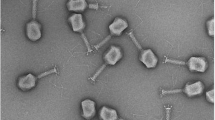Abstract
The authors study the Dienes effect in 136 P. mirabilis and 2 P. vulgaris strains, isolated from different infection or colonization sites, in 27 spinal cord injured patients, admitted to a Paraplegic Unit, during a 9 month period. It is shown that 7 cross-infection and 18 cross-contamination episodes occurred, affecting 13 of 27 patients, which indicates the great spreading capacity of these microorganisms; 97% of the results obtained were observed once again after 6 months' storage of strains. In addition, in 7 of these strains their resistance to several antibiotics was cured by treating them with acriflavine salts, demostrating that the Dienes effect persists even when resistance to antibiotics is modified; the authors conclude that the Dienes effect is an accurate stable epidemiological tool to identify cross-infections and its origins, and to facilitate the interruption of the chain of infection.
Similar content being viewed by others
References
AberR. and MackelD.C. (1981): Epidemiologic typing of nosocomial microorganisms. - Am. J. Med., 70: 899–905.
BelyavinG. (1951): Cultural and serological phases of Proteus vulgaris. - J. Gen. Microbiol., 5: 197–207.
Herruzo-CabreraR., Garcia-CaballeroJ., Garcia-RenesesJ. and Rey-CaleroJ. (1984): The use of the Dienes test in the epidemiology of Proteus urinary tract infection in patients with spinal cord disease. - J. Hosp. Infect., 5: 92–95.
LennetteE.H., BalowsA., HauslerW.J. and TruantJ.P. (1980): Manual of Clinical Microbiology. Third Ed. American Society for Microbiology. Washington. 78–81 and 463–473.
Perez-FidalgoF.J. (1983): Epidemiologia de plásmidos de resistencia en UVI. Diseminación de una Klebsiella pneumoniae multirresistente. Tesis de Licenciatura. Facultad de Medicina. Universidad Autónoma Madrid.
SeniorB.W. (1977): Typing of Proteus strains by proteicine and sensitivity. - J. Med. Microbiol., 10: 7–17.
SeniorB.W. (1977): The Dienes phenomenon: identification of the determinants of compatibility. -J. Gen. Microbiol., 102: 235–244.
SkirrowM.B. (1969): The Dienes (mutual inhibition) in the investigation of Proteus infection. -J. Med. Microbiol., 2: 471–477.
StammW.E. (1983): Measurement of pyuria and its relationship to bacteriuria. - Am. J. Med. (Suppl.), 75: 53–58.
StoryP. (1954): Proteus infection in hospital. -J. Pathol. Bacteriol., 68: 55–62.
TracyG. and ThomsonJ. (1972): An evaluation of three methods of typing organisms of the genus Proteus. - J. Clin. Pathol., 25: 69–72.
Author information
Authors and Affiliations
Additional information
Corresponding author.
Rights and permissions
About this article
Cite this article
Herruzo-Cabrera, R., Garcia-Caballero, J., Medrano-Albero, M.J. et al. The dienes effect as an epidemiological tool in a paraplegic unit. Eur J Epidemiol 4, 212–215 (1988). https://doi.org/10.1007/BF00144754
Issue Date:
DOI: https://doi.org/10.1007/BF00144754




